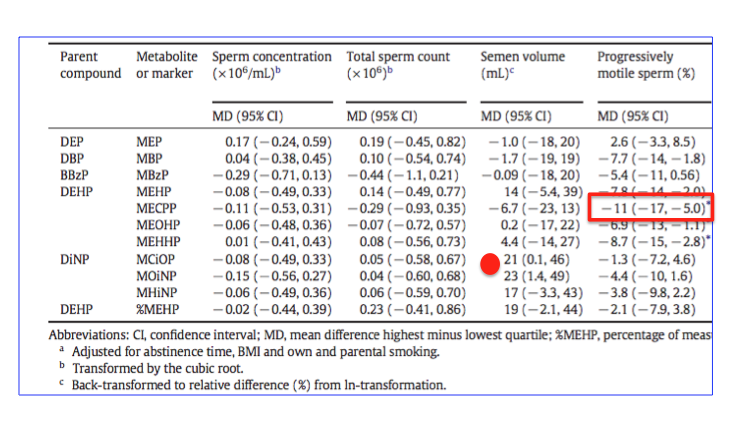 According to a new paper just published in Environment International, men with higher exposure to diethylhexyl phthalate (DEHP) have lower sperm motility less capable of moving spontaneously and may therefore experience more difficulties conceiving children.
According to a new paper just published in Environment International, men with higher exposure to diethylhexyl phthalate (DEHP) have lower sperm motility less capable of moving spontaneously and may therefore experience more difficulties conceiving children.
Sounds scary. But is there anything to this knock on DEHP, one of a group of chemicals called phthalates?
It doesn't take long to see that there isn't.
Without going through the entire seven-page paper a task that is onerous enough on its own to make you infertile (whether you've even been exposed to phthalates or not) I will just point out a few glaring deficiencies:
To start with, the paper reported on the study of metabolite levels of DEHP (which is used to make plastics softer, and one of the many phthalates that are used) in urine as an indicator of exposure, as well as the semen quality (and quantity) of 300 men between the ages of 18 and 20.
Red flags 1-3:
- Like most chemicals and drugs, phthalates are metabolized in the liver to give water-soluble metabolites, which are then excreted in the urine. The use of urinary metabolites as a surrogate marker of exposure to the drug, or chemical, is of questionable value at best, and quite possibly it's all together meaningless. They could simply be measuring individual's metabolic efficiency.
- The (ahem) sample size is small, but as you'll see below, it gets even lower once divided into quartiles.
- There are dozens of phthalates that are used. The group measured six, and drew its conclusions from two of them: DEHP and DEP.
If that's not bad enough, it gets worse.
The data were analyzed by comparing quartiles breaking the 300 men into four groups based on the magnitude of the difference that was measured a fairly common way to detect (read: manufacture) an effect. But it's a bad way to get real information.
Red flags 4-6 (see table)
4. Even with DEHP, what the authors claim to be the most toxic phthalate (it's nothing of the sort), the difference in sperm motility between the highest quartile and lowest, as measured by DEHP metabolite, is a ridiculous 11 percent. The data are 57 percent motility in the highest quartile vs. 46 percent in the lowest. I would hide in a vault if I ever published something like this.
5. A different phthalate called DINP was found to increase semen volume (red circle). Puhleeeeaze. Does anyone really believe that exposure to very small amounts of one phthalate (but not the others) is going to increase your semen volume?
6. Because if you are sane and do not believe this, then you have to wonder about the validity of the zillion other things that the researchers measured.

Two numbers on this chart supply all the information you need to know:
In the red rectangle is the essence of the paper, a statistically significant but clearly nonsensical result when taken with all the other data (lack thereof, really). An 11 percent difference between the highest quartile and the lowest in dataset filled with other meaningless numbers is so clearly an artifact. When you throw in the semen volume increase (red circle) it becomes immediately obvious that you would do as well throwing darts at the dataset or your cup of semen.
Save your time. Put the seven pages where they belong:



